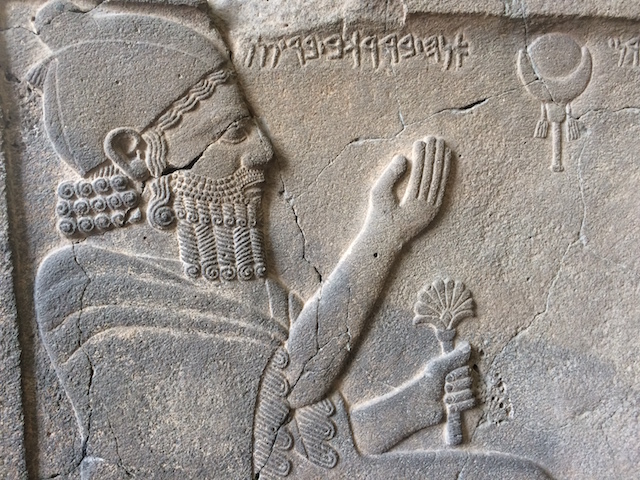
This ancient inscription caught my eye as I walked through the Pergamon Museum in Berlin in November 2015. The inscription above the raised hand says, “I am Barrakib, son of Panammu[wa].” King Barrakib ruled in Sam’al (modern Zincirli) in Turkey. The inscription, dating from approximately 730 BC is written in ancient Aramaic with the old Phoenician script.
Barrakib is pretty close to my own name, Barrick, so I was immediately fascinated. Now, I am certain that anyone who knows me will know that I am not Barrakib, regardless of any faint similarity of names. The man has an impressive beard and apparently quite a head of hair under that cap. I’m about as bald as the moon disk to the right of the inscription–barbers charge a finder’s fee to cut my hair. And, please note that the man lived 2746 years ago. I really am not that old, no matter what my students and some friends think–no, Bryan, I was not on the ark with Noah. Barrakib was a king over a small kingdom; I am only “king” in my own home when my “queen” graciously allows me to act like one (she’s a sweetheart to whom I have been married for one month short of 50 years–I doubt if Barrakib managed to experience such longevity in his marriage).
Although I’m using a good deal of exaggeration in making any comparison between myself and Barrakib, my point is that “Similarity does not equal identity”: ≈ ≠ =. This principle reminds us that we must be very cautious when we are interpreting Scripture. Sometimes we assume that similarity actually means identity, but it results in doing violence to the text.
Let’s take just one example: In the Book of Job about one-third of its vocabulary occurs in Ugaritic poetry. In his Anchor Bible commentary, Marvin Pope points out many ideological similarities between the Book of Job and Aqht, a Ugaritic poetic epic. He appeals to such similarities in order to date the composition of Job to the middle of the second millennium BC.[1] However, this kind of argumentation based upon similarities has ignored the great number of dissimilarities and the disharmonies presented by such a conclusion. Ugaritic (Canaanite) literature dates from 1550-1200 BC. That is the period of Moses on into the times of the biblical Judges. Such dating for Job would require someone like Moses to be the author, or someone even later.
Evidence internal to the Book of Job, however, indicates that the events took place in the patriarchal period (late third millennium to early second millennium BC). Like the patriarchs, Job lived a nomadic lifestyle and as the head of his family he fulfilled a priestly role. In biblical history, the qesitah (קְשִׂיטָה) as a medium of monetary exchange mentioned in Job 42:11 appears to have been used no later than the time of the patriarch Jacob (Gen 33:29; Josh 24:32). In addition, we have to consider the absence of any reference to Israel or any Israelite entity historically or culturally or religiously (such as Tabernacle, Temple, Law, Levites, etc.). All the evidence points to a patriarchal dating at least as early as 1800 BC, if not earlier. Then, of course, there are all of the claims for the fairly extensive use of Aramaic vocabulary in the Book of Job. However, the Aramaic of Job could be closely related to the Aramaic of Laban and Jacob (see Gen 31:46–53, esp. v. 47; and Deut 26:5), still making it patriarchal in the date of its events, if not also its composition. Most of the Aramaic vocabulary occurs in the dialogs between Job and his friends, so the vocabulary, if the dialogs have been accurately recorded, should also reflect the times in which the conversations took place.
Therefore, if 2100-1800 BC fits better the events in Job, similarities with Ugaritic and Aramaic vocabulary do not mean that the book’s events or its composition took place sometime in the time of Moses or later. Similarity does not equal identity.
[1] Marvin H. Pope, Job, rev. ed., ABC 15 (Garden City, NY: Doubleday & Company, Inc., 1965), XL.
